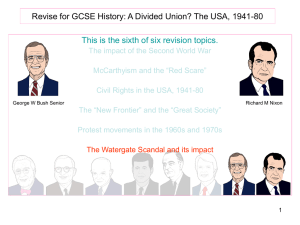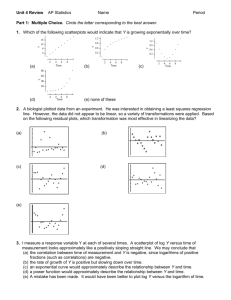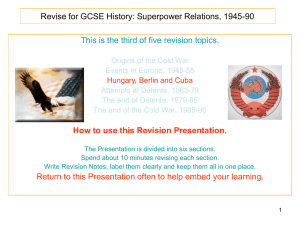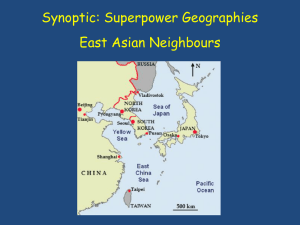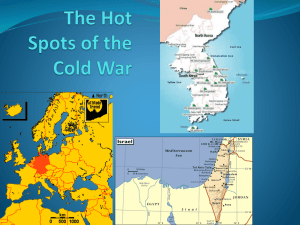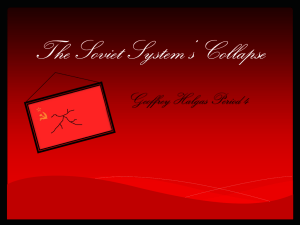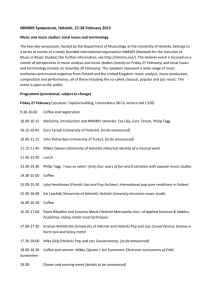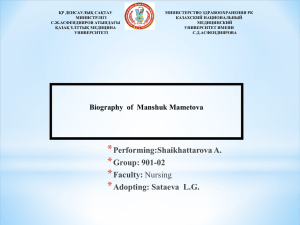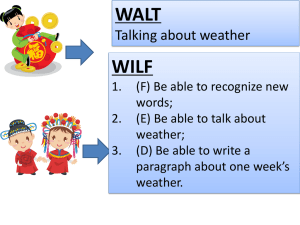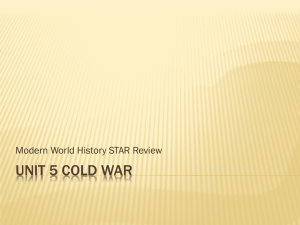Revise for GCSE Humanities: The 1950`s
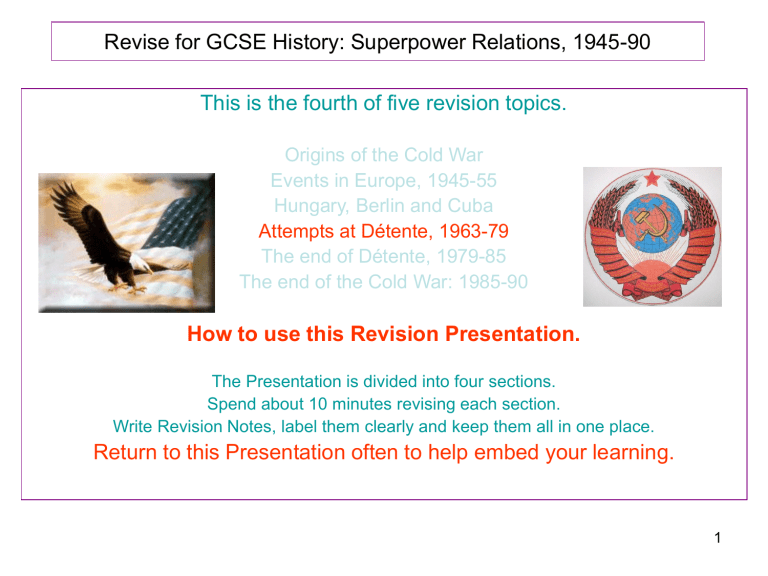
Revise for GCSE History: Superpower Relations, 1945-90
This is the fourth of five revision topics.
Origins of the Cold War
Events in Europe, 1945-55
Hungary, Berlin and Cuba
Attempts at Détente, 1963-79
The end of Détente, 1979-85
The end of the Cold War: 1985-90
How to use this Revision Presentation.
The Presentation is divided into four sections.
Spend about 10 minutes revising each section.
Write Revision Notes, label them clearly and keep them all in one place.
Return to this Presentation often to help embed your learning.
1
Revise for GCSE History: Superpower Relations, 1945-90
There are four sections to this topic.
What was the impact of the Cuban Missiles Crisis?
What were the key features of SALT 1?
How important were the Helsinki Agreements?
What were the key features of SALT II?
Spend about 10 minutes revising each section.
Write Revision Notes, title them clearly and keep them all in one place.
2
Revise for GCSE History: Superpower Relations, 1945-90
What was the impact of the Cuban Missiles Crisis?
People had been so scared by Cuba, there was a period of increased détente.
Hot Line telephone link between Moscow and Washington.
Partial Nuclear Test Ban Treaty.
Rising tensions: Brezhnev and Czechoslovakia
Brezhnev Doctrine: if communist country threatened by capitalist country other communist countries would intervene by using force.
Six Day War of 1967 between Arabs and Israelis. US supplied Israel, drove Arab States towards Moscow.
Soviet invasion of Czechoslovakia 1968. US did nothing due to presidential election and Vietnam War.
Nixon and Detente
Nixon’s wanted to end war in Vietnam. Visited Moscow and China.
Brezhnev did not want a US-Chinese alliance and acted as go-between in US-Hanoi negotiations.
Brezhnev wanted access to US technology and further grain sales.
Nixon agreed to take part in European Security Conference (from which Helsinki Agreements emerged).
Vietnam War ended in 1973.
3
Revise for GCSE History: Superpower Relations, 1945-90
What were the key features of SALT 1?
Strategic Arms Limitation Talks. Talks held Vienna and Helsinki for three years.
Anti-Ballistic Missiles Treaty (ABMs) allowed at only 2 sites.
Interim Agreement on Offensive Arms – 5 year freeze on number of ICBMs and SLBM launchers. Each side allowed to use satellites to check the other side was complying.
But: Strategic bombers and their bombs not limited. No restrictions on MIRVs.
Both sides supplied their allies in the Arab-Israeli War of 1973.
Nixon’s visit to Moscow
(July 74). Agreed: to continue to reduce tension, to limit and eventually end the arms race, try to reduce international tension, develop broad, mutually beneficial co-operation in economic, scientific and cultural fields, to promote understanding between countries.
Apollo-Soyuz link in space 17:7:75
4
Revise for GCSE History: Superpower Relations, 1945-90
How important were the Helsinki Agreements?
August 1975.
Helsinki Agreement signed by 35 countries (including USSR and USA).
Declaration of Human Rights.
Current borders of Europe accepted, so tensions reduced.
Demonstration of commitment to improve relations.
5
Revise for GCSE History: Superpower Relations, 1945-90
What were the key features of SALT II?
Talks began in 1974 and treaty signed in June 1979.
US President Carter keen to link arms limitations to human rights issues.
Carter writes to Andrei Sakarov, Soviet dissident. Seen as by Soviets as gross interference.
Helsinki Groups set up in eastern Europe to monitor Soviet adherence to Helsinki.
Human rights issue embarrassment for Brezhnev. Soviet Union accused of restricting free speech and freedom of movement. Soviets involved in Africa. Carter increases defence budget.
Key features of SALT II
Limit of 2,400 missiles for each side and 1,350 MIRVs.
Limits on new ICBM launchers and on deploying new weapons.
To last until 1985, but the Treaty was never ratified.
US Congress did not believe that they could check adherence by the USSR.
2000 Soviet troops on Cuba.
1979 NATO deploy long range missiles in Europe. 25:12:79 Soviet Union invades Afghanistan.
.
6
